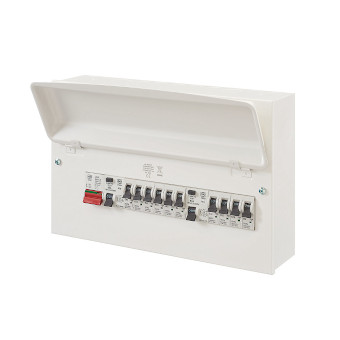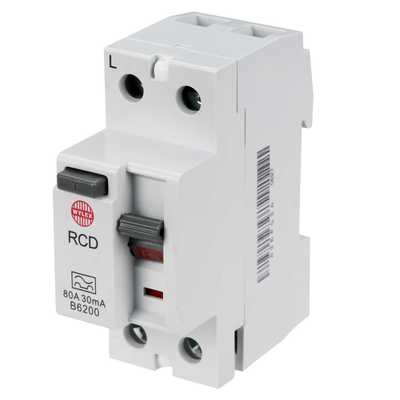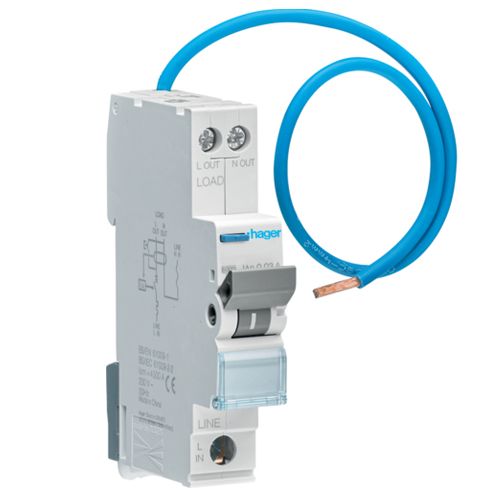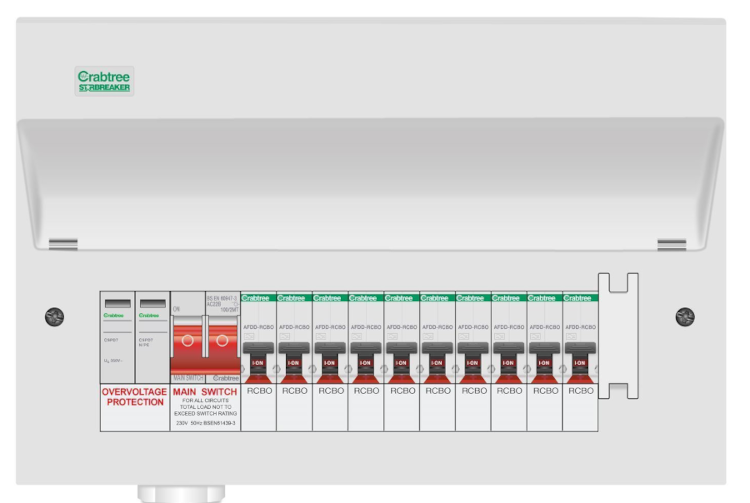Information about some of the products we test and install:
A. Protective Devices:
1. MCB
2. RCD
3. RCBO
4. SPD
5. AFDD
- MCB
The miniature circuit breaker (MCB) has been the basic level of domestic electrical circuit protection for many years now. Originally used to replace rewireable and cartridge fuses, the MCB is essentially a mechanical, resettable fuse. Offering convenience from a switch to operate if the device trips or to use for maintenance – to replace a light fitting for example. No risk of replacing the incorrect size fuse wire leading to a fire risk as with rewireable fuses. These devices are still in common use, and the modern version complying with BS 60898 is widely fitted today.

When installing a new circuit, rewiring a property or replacing a consumer unit, circuit protection provided by MCB alone is no longer adequate. In fact, almost all electrical accessories – light fittings, towel radiators, outdoor sockets, etc require RCD protection to comply with the manufacturer’s instructions.
Changes in the regulations has resulted in the standard set up for a domestic consumer unit has been what is known as the ‘dual RCD’ configuration.

Dual RCD consumer units have been the default configuration for the last 10-15 years. Each individual circuit is provided by short-circuit and overcurrent protection by the MCB and a group of 3-6 MCBs is jointly offered additional electric shock protection by a RCD (SEE RCD BELOW). Two RCDs are typically used (hence the dual RCD name) with two sets of circuits.
As more advanced forms of protection have been developed the MCB is still used, but must now be used in conjunction with other devices – the limits of its effectiveness are starting to show in comparison with the RCBO (SEE RCBO BELOW).
2. RCD
The term RCD (residual current device) applies to several different types of device, all designed to disconnect the electrical supply in the event of an earth fault. Essentially an RCD provides electric shock protection. In a domestic setting, RCDs have been a recommendation in the regulations, then a requirement for certain circuits and today in the latest 18th edition of BS7671 they are required for all circuits within a property. There are so many situations where RCD protection is required – cables buried within walls, socket outlets, circuits supply items in a bathroom, cables passing through a bathroom and now all luminaires or light fittings – within a domestic property that this level of protection being provided is now a basic assumption whenever electrical work is carried out. In some cases, this will involve adding RCD protection to the circuit being worked on in other cases it will be more beneficial to replace the consumer unit and bring the rest of the installation (all other
circuits) up to current requirements.

Under the 18th edition of the regulations, the dual-RCD configuration will not automatically comply and a RCBO (SEE RCBO BELOW) protected consumer unit is a better option to ensure compliance.
Nuisance tripping is cause when an RCD disconnects the supply to one or more circuits due to a fault on a separate circuit. In a dual-RCD configured consumer unit, water ingress in a floodlight connected to the downstairs lighting circuit would cause all circuits protected by the same RCD to be disconnected. This will typically include the upstairs sockets and possibly kitchen sockets, electric shower, cooker, garage, smoke alarms depending on the configuration of the consumer unit. In a RCBO-only configured consumer unit the only circuit to be disconnected would be the affected one – in the above example the downstairs lights. This makes for a safer situation (it is possible to use lamps plugged into sockets of it happens at night for example) as well as convenience and makes it easier to identify the cause of the tripping.
3. RCBO
An RCBO is a protective device fitted in a consumer unit that combines the protective roles of an MCB (short circuit and over current protection) with the additional electric shock protection of an RCD. This device takes up the same amount of room inside a consumer unit enclosure (one module), so it is possible to have a smaller enclosure without the need for separate RCDs.
RCBOs address the issue of nuisance tripping – the disconnection of unaffected circuits by a fault on an unrelated circuit – as each circuit is independently protected, in effect each RCBO is ‘unaware’ of the existence of other circuits in the installation or property. This increases the compliance with the 18th edition – the current version – of BS7671.

An RCBO will have a test button (as will any RCD) and this should be used every six months to ensure that the electrical supply is disconnected. Carrying out this test will confirm correct operation of the device and will also ensure that the mechanical parts of the device are not in danger of seizing up though lack of use – as may be the case otherwise.
At Kent Consumer Units our ‘standard’ configuration for a replacement consumer unit is each circuit protected by its own RCBO with entire property protected by a surge protection device (SPD see below). For customers looking for the highest level of protection currently available or those in a property with a higher level of fire risk then please read about arc fault detection devices (AFDDs) below.
4. SPD
Overvoltages (surges) may have atmospheric causes (lightning) or may be a result of switching or starting of high-powered industrial equipment in the proximity.
Overvoltages can spread through both the power supply and earthing systems potentially destroying sensitive equipment.
Transient overvoltages cause the premature ageing of equipment connected to the electricity network and may even destroy it if the surge is large enough.
Appliances such as televisions, computers, smoke alarms, fridges, boilers, hi-fi equipment and most other household appliances with electronic controls are all vulnerable to damage from electrical surges.
Surge Protection Devices (SPDs) limit the overvoltage to a level within the impulse voltage resistance of the protected equipment. They are usually installed within the consumer unit and feature a visible (colour-coded) indication of correct function. Each SPD has a replaceable cartridge when no longer functioning. If required, an SPD can be installed in a separate enclosure in order to retro-fit to an existing installation.

The wiring regulations (BS 7671) require protection to be provided (in all types of premises) where overvoltages could cause:
- Serious injuries to people
- Loss of human life
- Interrupt public services
- Damage cultural heritage
- Interrupt commercial/industrial activities
- Affect a large number of individuals at one location
In all other circumstances a risk assessment must be conducted to establish whether or not protection is required. If no risk assessment is carried out then protection must be provided.
Where the value of the installation and equipment within justifies it, overvoltage protection must be provided in a single unit domestic dwelling.
Kent Consumer units recommends fitting a surge protective device (SPD) as part of a consumer unit installation or replacement to provide overvoltage protection and to ensure compliance with the regulations.
5. AFDD
Arc faults are commonly caused by loose connections, damaged cable insulation, compressed cables, poorly made connections and deterioration of cable insulation due to age. These types of faults may lead to overheating and ignition of the insulation of the cable and combustion of any surrounding flammable materials.
There are requirements within the wiring regulations (BS 7671 – that every qualified electrician will work to) to ensure that the electrical installation is designed so that the wiring systems are protected against the type of damage that can led to arc faults. There are also requirements for every electrical connection to provide durable continuity and adequate mechanical strength, however, electrical fires continue to start and harm life and property.
There are requirements in BS 7671 for the use of RCDs as fire protection, however, they offer limited protection from arc faults, depending on their rated operating current and are unable to detect some arc faults at all. Generally designed to protect against electric shock, RCDs have been the best additional protective measure against fire.
The 18th edition of BS 7671 introduced the use of Arc Fault Detection Devices (AFDDs). These devices are designed to detect an arc fault and disconnect the electrical supply before ignition can occur.
UK government statistics show that 53.4% (14186) of all accidental dwelling fires have an electrical origin. These fires resorted in damage to property, injury to occupants of the buildings and in some cases fatalities. Many of these fires were preventable.
In much the same way that the use of RCDs to prevent electric shock must not lead to complacency and short cuts in the fundamentals of electrical safety (correct earthing and bonding etc) AFDDs offer an additional layer on top of the following correct installation procedures and the use of carefully selected materials appropriate for the environment.
The latest versions of AFDDs only take up the same room inside a consumer unit as an MCB or RCBO (1 module), unlike the larger original devices and can be retro fitted into a compatible enclosure – for example a Wylex AFDD can be installed inside an existing (modern) Wylex consumer unit, either to supply a new circuit or to replace the existing MCN or RCBO. This particular device combines an AFDD with an RCBO – offering the highest level of protection currently available.

Kent Consumer Units install replacement fuse boxes throughout Kent and South East England. Our recommendation for the highest level of electrical safety within a domestic property would be an 18th edition compliant enclosure (metal and essential today) fitted with a Surge Protection Device (SPD) alongside the main switch and individual protection for each circuit provided by single module combined Arc Fault Detection Devices. As each AFDD also operates as an RCBO, additional shock protection is built-in without the need for a separate RCD. This would represent a sizeable investment starting at £1500 for an average sized property (total cost would depend upon the number of circuits, please contact us for a no-obligation quote), but would ensure compliance with the regulations for many years to come and peace of mind knowing the best available protection against electric shock and fire is in place.
A single module AFDD combines the short-circuit and overcurrent protection duties of an MCB, the earth fault additional protection of and RCD with arc fault detection that can prevent fires.
RCDs save lives and prevent injury by preventing electric shock and AFDDs do likewise by preventing the cause of many electrical fires.
AFDDs can be fitted to some or all circuits in an installation. Whilst these devices have only recently featured in the regulations and are a recommendation rather than a requirement in most domestic properties, there are situations where they are required, depending on the fire risk present. A higher than normal fire risk may be due to wooden buildings and structures made from combustible materials or high-rise buildings with a complex escape route.
